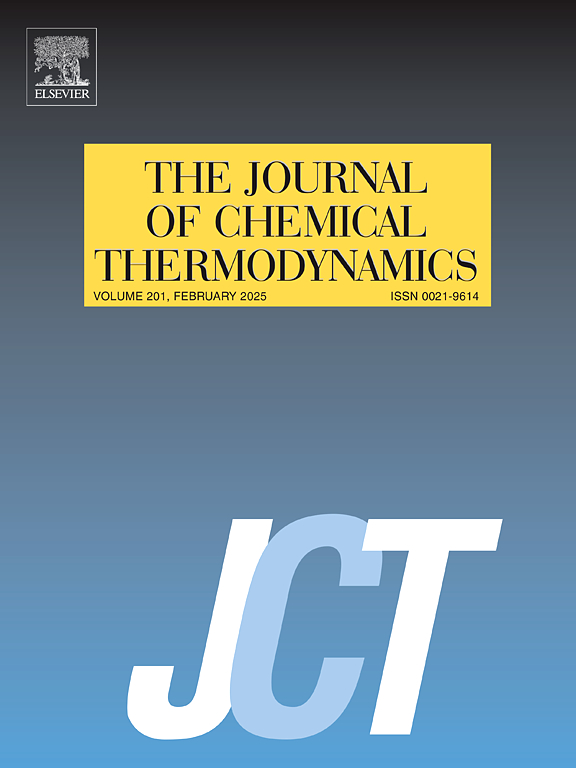2,2 ',4,4 ',6,6 ' -六硝基联苯在11种纯溶剂中的溶解度测定、模型评价和热力学分析
IF 2.2
3区 工程技术
Q3 CHEMISTRY, PHYSICAL
引用次数: 0
摘要
采用激光动态法测定了2,2′,4,4′,6,6′-六硝基联苯在11种纯溶剂(丙酮、环己酮、2-丁酮、乙酸甲酯、乙酸乙酯、苯、氯苯、吡啶、乙腈、1,2-二氯乙烷和1,4-二恶烷)中的溶解度,温度范围为293.15 K ~ 333.15 K,压力为101.3 kPa。研究发现,2,2 ',4,4 ',6,6 ' -六硝基联苯的溶解度与温度升高呈正相关。采用改进的Apelblat模型、van't Hoff模型、NRTL模型和Wilson模型对实验数据进行了关联。修正后的Apelblat模型具有较好的相关性能。采用Hirshfeld表面和分子静电电位表面分析研究了溶剂-溶质相互作用位点,以及相互作用对2,2 ',4,4 ',6,6 ' -六硝基联苯在11种选定的纯溶剂中溶解度的影响。此外,利用van't Hoff模型计算了2,2 ',4,4 ',6,6 ' -六硝基联苯在11种选定的纯溶剂中的溶解过程的热力学性质,结果表明,2,2 ',4,4 ',6,6 ' -六硝基联苯在11种选定的纯溶剂中的溶解是一个吸热的熵递增过程。本文章由计算机程序翻译,如有差异,请以英文原文为准。
Solubility determination, model evaluation and thermodynamic analysis of 2,2′,4,4′,6,6′-hexanitrobibenzyl in eleven pure solvents
The solubility of 2,2′,4,4′,6,6′-hexanitrobibenzyl in eleven pure solvents (acetone, cyclohexanone, 2-butanone, methyl acetate, ethyl acetate, benzene, chlorobenzene, pyridine, acetonitrile, 1,2-dichloroethane and 1,4-dioxane) was measured by laser dynamic method at the temperature range from 293.15 K to 333.15 K under the pressure of 101.3 kPa. The study found that the solubility of 2,2′,4,4′,6,6′-hexanitrobibenzyl is positively correlated with increasing temperature. The experimental data were correlated using four thermodynamic models: the modified Apelblat model, van't Hoff model, NRTL model, and Wilson model. The modified Apelblat model demonstrated superior correlation performance. Hirshfeld surface and molecular electrostatic potential surface analysis were also conducted to investigate the solvent-solute interaction sites and the effects of interactions on the solubility of 2,2′,4,4′,6,6′-hexanitrobibenzyl in eleven selected pure solvents. Additionally, the thermodynamic properties of the dissolution process were calculated using the van't Hoff model, and the results indicated that the dissolution of 2,2′,4,4′,6,6′-hexanitrobibenzyl in eleven selected pure solvents is an endothermic and entropy-increasing process.
求助全文
通过发布文献求助,成功后即可免费获取论文全文。
去求助
来源期刊

Journal of Chemical Thermodynamics
工程技术-热力学
CiteScore
5.60
自引率
15.40%
发文量
199
审稿时长
79 days
期刊介绍:
The Journal of Chemical Thermodynamics exists primarily for dissemination of significant new knowledge in experimental equilibrium thermodynamics and transport properties of chemical systems. The defining attributes of The Journal are the quality and relevance of the papers published.
The Journal publishes work relating to gases, liquids, solids, polymers, mixtures, solutions and interfaces. Studies on systems with variability, such as biological or bio-based materials, gas hydrates, among others, will also be considered provided these are well characterized and reproducible where possible. Experimental methods should be described in sufficient detail to allow critical assessment of the accuracy claimed.
Authors are encouraged to provide physical or chemical interpretations of the results. Articles can contain modelling sections providing representations of data or molecular insights into the properties or transformations studied. Theoretical papers on chemical thermodynamics using molecular theory or modelling are also considered.
The Journal welcomes review articles in the field of chemical thermodynamics but prospective authors should first consult one of the Editors concerning the suitability of the proposed review.
Contributions of a routine nature or reporting on uncharacterised materials are not accepted.
 求助内容:
求助内容: 应助结果提醒方式:
应助结果提醒方式:


